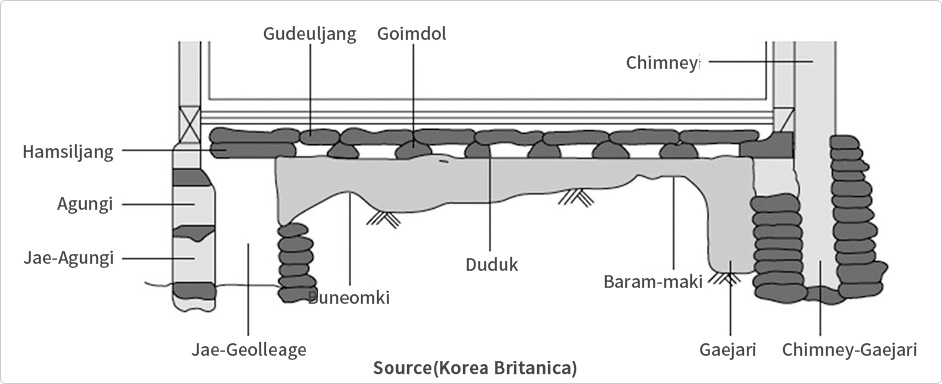Structure
Ondol design structure has a slight difference depending on the era and region. If make Ondol meeting with the most basic requirement only, its structure is make a fire at the fuel hole and heat of that fuel hole is gone out into the chimney passing through the Gorae of the Gudeuljang. Sequence to pass by the smoke which contained the heat of fire is as follows.

1. Fuel Hole
Fuel hole of cooking fireplace: It is a place to make a fire and generate heat.
- ㆍ In case that room is small, Woebang Gudeul is connected to a one fuel hole (or two fuel holes).
- ㆍ Couple of fuel holes used to stick and connect to a one Gudeul(room), and couple of Gudeuls used to connect to a one fuel hole, depending on the room size or house structure etc.
- ㆍ Small house is comprised of a one with a cooking fireplace of the kitchen, and in the big house a separate heating fuel hole used to put every room or building.
- ㆍ Since fuel hole of the cooking fireplace is supposed to put lower than the Gudeul, floor of the kitchen belongs to the lowest height area in the house.
- ㆍ As the fire burning from the fuel hole of the cooking fireplace combines a heating a and a cooking, there are lots of cases that cooking fireplace height of the conventional kitchen despite kitchen floor is low is under the waist extent.
This is a design to cause inconvenience of user when in cooking labor.
Bulmok(the warmest part of the heated floor)
Bulmok : (Bulgogae, buneomki or bunangki): It is a place where make the heat generated from the fuel hole enter into the room floor(Gudeul).
- ㆍ It is a passage of the heat connected to the Gorae under the Gudeuljang beginning from the cooking fireplace wall face that hangs up a kettle.
- ㆍ It is a hilly space where pass the heat enetered through the fuel hole rear side(Hulungi) to the Gudeulgaejari and Gorae. It should make controlling its width and height in order for the strong heating power to suck in orderly fashion.
- ㆍ Prop a stone above the Bulmok, and can control the inflow amount of the heat as adjust width of the Bulmok by this.
- ㆍ In severe cold area such as North Korea or Manchuria etc shape of the Bulmok is formed with a wide big structure close to the Dunduck so as to receive much heat.
- ㆍ If Hulungi and Bulmok are too narrow, heat is not sucked, entered in orderly fashion.
- ㆍ If Hulungi and Bulmok are too wide, when heat of fire is none, Gudeul gets cold fast since air of the outside kitchen is flowed in as it is.
- ㆍ Bulmok gives a big influence to heat efficiency such as fuel volume when make a fire and 'remaining warmth' of the whole Gudeul after the fire is extinguished and so on.
3. Gudeulgaejari
Gudeulgaejari: It corresponds to the room's first part and this upper part is corresponded to the place on the Ondol floor nearest the fireplace.
- ㆍ It exists before the Gorae begins, and is a combined place of both air and heat that are deeply dug than the Gorae.
- ㆍ It is a practical first introductory part that drops the heat speed transmitted from the Bulmok and that gives a help to heating when heat is mixing, spreading with a relatively cold air in the Gudeul.
- ㆍ Gudeuljang of this part (place on the Ondol floor nearest the fireplace) is thickly laid than the Gudeuljang of the upper side of the floor away from the fireplace.
- ㆍ Length and breadth are smaller than the 1 piece Gudeuljang stone plate, and depth is approx 30cm extent from the Gorae floor though, its size and depth differs depending on the regional temperature and other design.
For severe cold region, shallow Gudeulgaejari and big Bulmok are designed.
Gudeuljang
- ㆍ Ancestors of Korea primarily used mica for the Gudeuljang.
- ㆍ They used white mica out of it because white mica is that heat preservation time was big, and was an insulator.
- ㆍ Mineral which is mainly called mica is mostly contained in other rocks being used for the Gudeuljang.
